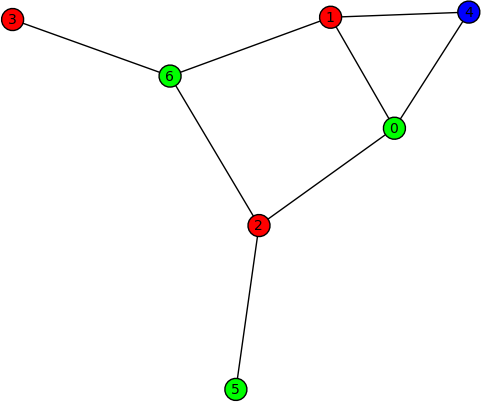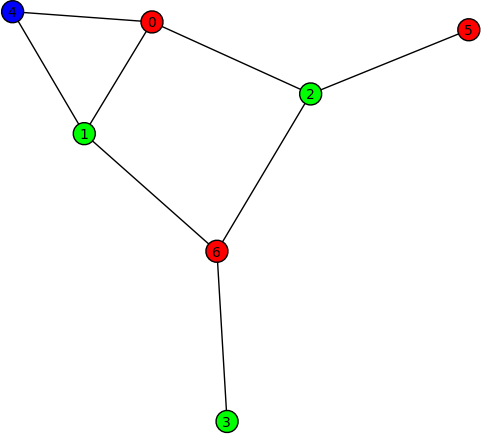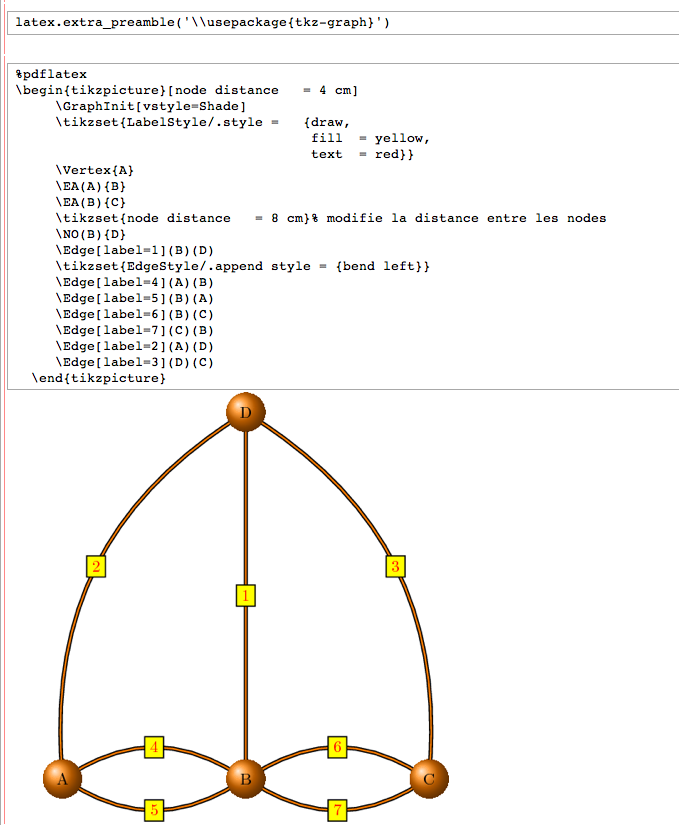|
Size: 2435
Comment: Reminders to showcase features
|
Size: 4690
Comment: Summarize #6039, #6012, #5889
|
| Deletions are marked like this. | Additions are marked like this. |
| Line 10: | Line 10: |
| * FIXME: summarize #5997 | * Deprecate the {{{order()}}} method on elements of rings (John Palmieri) -- The method {{{order()}}} of the class {{{sage.structure.element.RingElement}}} is now deprecated and will be removed in a future release. For additive or multiplicative order, use the {{{additive_order}}} or {{{multiplicative_order}}} method respectively. |
| Line 15: | Line 16: |
| * FIXME: summarize #6010 | * Various invariants for genus 2 hyperelliptic curves (Nick Alexander) -- The following invariants for genus 2 hyperelliptic curves are implemented in the module {{{sage/schemes/hyperelliptic_curves/hyperelliptic_g2_generic.py}}}: * the Clebsch invariants * the Igusa-Clebsch invariants * the absolute Igusa invariants |
| Line 60: | Line 65: |
| * FIXME: summarize #5913 | * Graph colouring (Robert Miller) -- New method {{{coloring()}}} of the class {{{sage.graphs.graph.Graph}}} for obtaining the first (optimal) coloring found on a graph. Here are some examples on using this new method: {{{ sage: G = Graph("Fooba") sage: P = G.coloring() sage: G.plot(partition=P) sage: H = G.coloring(hex_colors=True) sage: G.plot(vertex_colors=H) }}} {{attachment:graph-colour-1.png}} {{attachment:graph-colour-2.png}} |
| Line 78: | Line 94: |
| * Viewing Sage objects with a PDF viewer (INSERT CREDIT) -- Implements the option {{{viewer="pdf"}}} for the command {{{view()}}} so that one can invoke this command in the form {{{view(object, viewer="pdf")}}} in order to view {{{object}}} using a PDF viewer. Typical uses of this new optional argument include: | * Viewing Sage objects with a PDF viewer (Nicolas Thiery) -- Implements the option {{{viewer="pdf"}}} for the command {{{view()}}} so that one can invoke this command in the form {{{view(object, viewer="pdf")}}} in order to view {{{object}}} using a PDF viewer. Typical uses of this new optional argument include: |
| Line 83: | Line 99: |
| * FIXME: summarize #6039 | * Change name of Pari's {{{sum}}} function when imported (Craig Citro) -- When Pari's {{{sum}}} function is imported, it is renamed to {{{pari_sum}}} in order to avoid conflict Python's {{{sum}}} function. |
| Line 97: | Line 113: |
| * FIXME: summarize #6012 | * Allow use of {{{pdflatex}}} instead of {{{latex}}} (John Palmieri) -- One can now use {{{pdflatex}}} instead of {{{latex}}} in two different ways: * Use a {{{%pdflatex}}} cell in a notebook; or * Call {{{latex.pdflatex(True)}}} after which any use of {{{latex}}} (in a {{{%latex}}} cell or using the {{{view}}} command) will use {{{pdflatex}}}. One visually appealing aspect of this is that if you have the most recent version of [[http://pgf.sourceforge.net|pgf]] installed, as well as the {{{tkz-graph}}} package, you can produce images like the following: {{attachment:pgf-graph.png}} |
| Line 142: | Line 164: |
| * FIXME: summarize #1338 * FIXME: summarize #6032 * FIXME: summarize #6024 |
|
| Line 156: | Line 184: |
| * FIXME: summarize #5889 | * Random simplicial complexes (John Palmieri) -- New method {{{RandomComplex()}}} in the module {{{sage/homology/examples.py}}} for producing a random {{{d}}}-dimensional simplicial complex on {{{n}}} vertices. Here's an example: {{{ sage: simplicial_complexes.RandomComplex(6,12) Simplicial complex with vertex set (0, 1, 2, 3, 4, 5, 6, 7) and facets {(0, 1, 2, 3, 4, 5, 6, 7)} }}} |
Sage 4.0 Release Tour
Sage 4.0 was released on FIXME. For the official, comprehensive release note, please refer to sage-4.0.txt. A nicely formatted version of this release tour can be found at FIXME. The following points are some of the foci of this release:
Algebra
Deprecate the order() method on elements of rings (John Palmieri) -- The method order() of the class sage.structure.element.RingElement is now deprecated and will be removed in a future release. For additive or multiplicative order, use the additive_order or multiplicative_order method respectively.
Algebraic Geometry
Various invariants for genus 2 hyperelliptic curves (Nick Alexander) -- The following invariants for genus 2 hyperelliptic curves are implemented in the module sage/schemes/hyperelliptic_curves/hyperelliptic_g2_generic.py:
- the Clebsch invariants
- the Igusa-Clebsch invariants
- the absolute Igusa invariants
Basic Arithmetic
Build
Calculus
Coercion
Combinatorics
- FIXME: summarize #5502
- FIXME: summarize #5586
Commutative Algebra
- FIXME: summarize #5576
- FIXME: summarize #5609
- FIXME: summarize #5566
Distribution
Doctest
Documentation
Geometry
Graph Theory
Graph colouring (Robert Miller) -- New method coloring() of the class sage.graphs.graph.Graph for obtaining the first (optimal) coloring found on a graph. Here are some examples on using this new method:
sage: G = Graph("Fooba") sage: P = G.coloring() sage: G.plot(partition=P) sage: H = G.coloring(hex_colors=True) sage: G.plot(vertex_colors=H)


Graphics
- FIXME: summarize #5249
Group Theory
- FIXME: summarize #5664
- FIXME: summarize #5844
Interfaces
Viewing Sage objects with a PDF viewer (Nicolas Thiery) -- Implements the option viewer="pdf" for the command view() so that one can invoke this command in the form view(object, viewer="pdf") in order to view object using a PDF viewer. Typical uses of this new optional argument include:
- You prefer to use a PDF viewer rather than a DVI viewer.
- You want to view LaTeX snippets which are not displayed well in DVI viewers (e.g. graphics produced using tikzpicture).
Change name of Pari's sum function when imported (Craig Citro) -- When Pari's sum function is imported, it is renamed to pari_sum in order to avoid conflict Python's sum function.
Linear Algebra
- FIXME: summarize #5974
- FIXME: summarize #5557
- FIXME: summarize #5381
Miscellaneous
Allow use of pdflatex instead of latex (John Palmieri) -- One can now use pdflatex instead of latex in two different ways:
Use a %pdflatex cell in a notebook; or
Call latex.pdflatex(True)
after which any use of latex (in a %latex cell or using the view command) will use pdflatex. One visually appealing aspect of this is that if you have the most recent version of pgf installed, as well as the tkz-graph package, you can produce images like the following:

Modular Forms
- FIXME: summarize #4337
- FIXME: summarize #4357
- FIXME: summarize #5262
- FIXME: summarize #5792
- FIXME: summarize #5796
- FIXME: summarize #6019
- FIXME: summarize #5924
Notebook
Number Theory
- FIXME: summarize #5250
- FIXME: summarize #6013
- FIXME: summarize #6008
- FIXME: summarize #6004
Numerical
Packages
- FIXME: summarize #4223
- FIXME: summarize #6031
- FIXME: summarize #5934
- FIXME: summarize #1338
- FIXME: summarize #6032
- FIXME: summarize #6024
P-adics
- FIXME: summarize #5105
Quadratic Forms
Symbolics
Topology
Random simplicial complexes (John Palmieri) -- New method RandomComplex() in the module sage/homology/examples.py for producing a random d-dimensional simplicial complex on n vertices. Here's an example:
sage: simplicial_complexes.RandomComplex(6,12) Simplicial complex with vertex set (0, 1, 2, 3, 4, 5, 6, 7) and facets {(0, 1, 2, 3, 4, 5, 6, 7)}
User Interface
